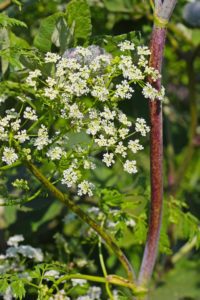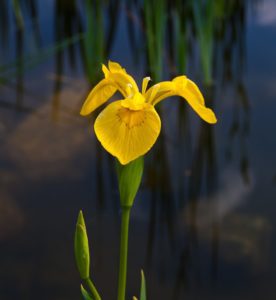Uncategorized
Back 40: A threat to the ecosystem
Published
6 years agoon
Posted By
Outlaw Partners
Noxious weeds in Big Sky
By John Councilman EBS Contributor
Invasive non-native plants, animals and diseases are getting more press and for good reason. Native ecosystems and all that depend on them are at risk.
Years ago, as a U.S. Forest Service land manager in Idaho, weeds weren’t on my radar screen. The scope of the problem didn’t sink in until I transferred to the Bozeman Ranger District and was given the responsibility of managing the district weed program. It didn’t take long to realize we have a problem.


Poison hemlock is increasing in abundance in the Big Sky area. All parts of this plant, which can grow as tall as 10 feet, are highly toxic. Use protective gear and extreme caution when removing, and be sure to dispose of the tap root and all plant material.
There are many threats to our local environment, however, I think the top threat is invasive species. The Center for Invasive Species Management reports invasive species are the second leading cause of animal population decline and extinction worldwide.
I have seen landscapes recover from every major calamity except invasive species. Once invasive species get established, nature has no mechanisms that enable landscapes to restore ecological balance. Evolution works slowly. Several weeds now established in the Big Sky area have the potential to completely transform our landscape.
It’s difficult to raise awareness about this issue. Weeds aren’t a glitzy endangered species that get a lot of press. However, fighting weeds protects the habitat these species live on.
Noxious weeds are plants designated as injurious to agricultural or horticultural crops, natural habitats or ecosystems, humans or livestock. There are hundreds of noxious weeds in North America, with 32 listed in Montana.
Noxious weeds come from all around the world. Those that thrive in similar growing conditions to the Big Sky area can become established here, often invading disturbed areas like roadsides, powerline clearings, trails, construction sites, and burned or logged areas. However, because they are so competitive, they can get established almost anywhere. And unlike native plants, they usually have no natural control like bugs that eat them or diseases that keep their populations in check.
Noxious weeds, among other things:
– Replace native plant communities
– Degrade water quality
– Reduce forage for wildlife
– Decrease property values
– Increase the severity and frequency of wildfires
– Eliminate recreational opportunities
Weeds spread easily via cars, ATVs, motorcycles, dogs, heavy equipment, livestock, hay, contaminated topsoil and gravel, hiking boots, clothing, fishing waders, etc.
Once noxious weeds are established along a river, their seeds float downstream, infesting gravel bars and river banks. This increases soil erosion and negatively affects fish habitat.


Last year, the invasive yellow flag iris was found for the very first time in Big Sky, growing among cattails in a private pond in the Beaver Creek area. The species forms dense monotypic colonies in riparian areas, crowding out native species, altering the ecosystem, and reducing habitat for wildlife, birds, fish and pollinators.
For example, research shows runoff increases by 150 percent and sediment yields by 300 percent in areas of invasive spotted knapweed.
Other wildlife is also affected. Spotted knapweed can reduce winter forage for elk by 50 to 90 percent. This can change seasonal elk distribution patterns.
Habitat decline is also a primary threat to our local bighorn sheep population. That’s why the Gallatin Invasive Species Alliance—formerly the Gallatin-Big Sky Weed Committee—partners with Montana Fish, Wildlife and Parks, and the Custer Gallatin National Forest to treat weeds on their winter range.
Things you can do:
– Learn to identify invasive species
– Clean plant materials and mud from boots, gear, pets and vehicles before and after using trails
– Drive only on designated routes
– Use local firewood and certified weed-free hay
– Plant native plants in your garden and remove invasive plants
– Avoid dumping aquariums or live bait into waterways
– Clean and dry your fishing waders and wading boots after each use
– Drain all water from your boat, including in the engine’s cooling system, live wells, and bilge
Getting educated is key. Learn to identify weeds to protect Big Sky from this severe problem. The Gallatin Invasive Species Alliance will visit your property in Big Sky for free and help you with weed issues.
Visit bigskyweeds.org for more information and additional resources.
John Councilman is a retiree from the U.S. Forest Service where he worked for 32 years, the last nine of which were spent as part of the Custer Gallatin National Forest Bozeman Ranger District. He has over 40 years of experience working in the northern Rocky Mountain area on a wide variety of vegetation and wildlife management issues. Councilman is currently the vice chair of the Gallatin Invasive Species Alliance.
A version of this article was first published in the Sept. 1, 2017, edition of EBS.
The Outlaw Partners is a creative marketing, media and events company based in Big Sky, Montana.


Upcoming Events
november, 2024
Event Type :
All
All
Arts
Education
Music
Other
Sports
Event Details
Spanish Classes with World Language InitiativeThese unique, no cost Spanish classes are made possible by the contribution of Yellowstone Club
more
Event Details
Spanish Classes with World Language InitiativeThese unique, no cost Spanish classes are made possible by the contribution of Yellowstone Club Community Foundation (YCCF) and Moonlight Community Foundation (MCF). This class will focus on building a lifelong affinity for world languages and cultures through dynamic and immersive Communicative Language teaching models.
Beginner Class – Mondays and Wednesdays from 5:30-6:30 pm
Intermediate Class – Mondays and Wednesdays from 6:45- 7:45 pm
- Classes begin Oct.7, 2024 and run for 6 weeks
- Class size is limited to 12 students
- Classes are held in Big Sky at the Big Sky Medical Center in the Community Room
For more information or to register follow the link below or at info@wlimt.org.
Time
October 21 (Monday) 5:30 pm - November 27 (Wednesday) 7:45 pm
Location
Big Sky Medical Center - Community Room (2nd Floor)
Big Sky Medical Center - Community Room (2nd Floor)
Event Details
Spanish Classes with World Language InitiativeThese unique, no cost Spanish classes are made possible by the contribution of Yellowstone Club
more
Event Details
Spanish Classes with World Language InitiativeThese unique, no cost Spanish classes are made possible by the contribution of Yellowstone Club Community Foundation (YCCF) and Moonlight Community Foundation (MCF). This class will focus on building a lifelong affinity for world languages and cultures through dynamic and immersive Communicative Language teaching models.
Beginner Class – Mondays and Wednesdays from 5:30-6:30 pm
Intermediate Class – Mondays and Wednesdays from 6:45- 7:45 pm
- Classes begin Oct.7, 2024 and run for 6 weeks
- Class size is limited to 12 students
- Classes are held in Big Sky at the Big Sky Medical Center in the Community Room
For more information or to register follow the link below or at info@wlimt.org.
Time
October 28 (Monday) 5:30 pm - December 4 (Wednesday) 7:45 pm
Location
Big Sky Medical Center - Community Room (2nd Floor)
Big Sky Medical Center - Community Room (2nd Floor)
Event Details
Spanish Classes with World Language InitiativeThese unique, no cost Spanish classes are made possible by the contribution of Yellowstone Club
more
Event Details
Spanish Classes with World Language InitiativeThese unique, no cost Spanish classes are made possible by the contribution of Yellowstone Club Community Foundation (YCCF) and Moonlight Community Foundation (MCF). This class will focus on building a lifelong affinity for world languages and cultures through dynamic and immersive Communicative Language teaching models.
Beginner Class – Mondays and Wednesdays from 5:30-6:30 pm
Intermediate Class – Mondays and Wednesdays from 6:45- 7:45 pm
- Classes begin Oct.7, 2024 and run for 6 weeks
- Class size is limited to 12 students
- Classes are held in Big Sky at the Big Sky Medical Center in the Community Room
For more information or to register follow the link below or at info@wlimt.org.
Time
November 4 (Monday) 5:30 pm - December 11 (Wednesday) 7:45 pm
Location
Big Sky Medical Center - Community Room (2nd Floor)
Big Sky Medical Center - Community Room (2nd Floor)









